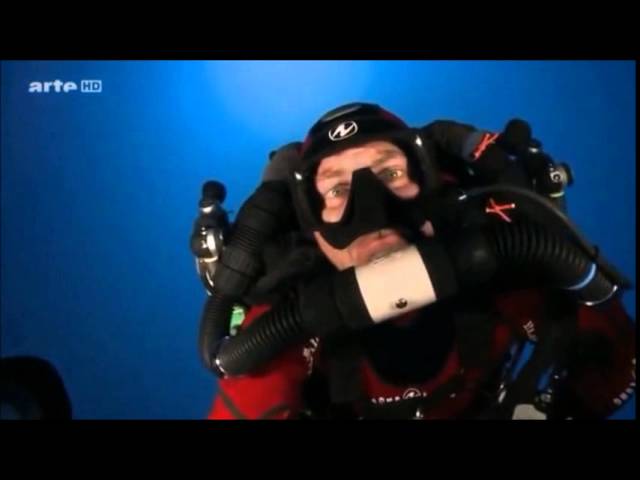Sometimes a photograph reveals things about the photographer. That is certainly true of this image of a coelacanth in its natural habitat, taken by French scientist and marine photographer Laurent Ballesta. To me the photo reveals previsualization, extraordinary dedication and careful execution. I knew it could not have happened by accident. Ballesta confirms and explains:
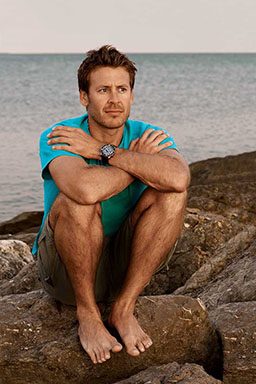
“I had in my mind’s eye a photograph of a coelacanth, not a fish-identification portrait (although I intended to shoot that as well) but a cover photo for my book, and I wanted to show it where it lived — in its own ecosystem. This happened to be off the coast of South Africa at 400 feet.”
“The idea was to shoot from a distance while a diver inside the cave with a strong dive light illuminated the cave to silhouette the coelacanth’s unique profile. The problem was that there were eight such caves in the area, and each time we went to the bottom we had to figure out which one might hold a fish. Coelacanths are not particularly shy, but they aren’t inquisitive either. We couldn’t expect the fish to come to us, so we had to find where one might be, and that took precious minutes away from each dive. We dived using rebreathers, and each dive afforded us only 35 minutes on the bottom while requiring five hours of decompression. With three or four divers searching the bottom for the first 12 minutes of every dive, we would find the fish maybe 30 percent of the time.”
“In the end it took 15 days of trying to get this shot. I don’t know whether to say I captured the image in 1/15 of a second or 120 hours, which is about how much time I spent traveling to the site, diving and maintaining my camera and rebreather during those weeks. If you consider I had the image in my mind when I was a graduate student reading about the coelacanth for the first time and dreaming of photographing one in the wild, this was the culmination of a 20-year quest, distilled down to that single press of my shutter.”
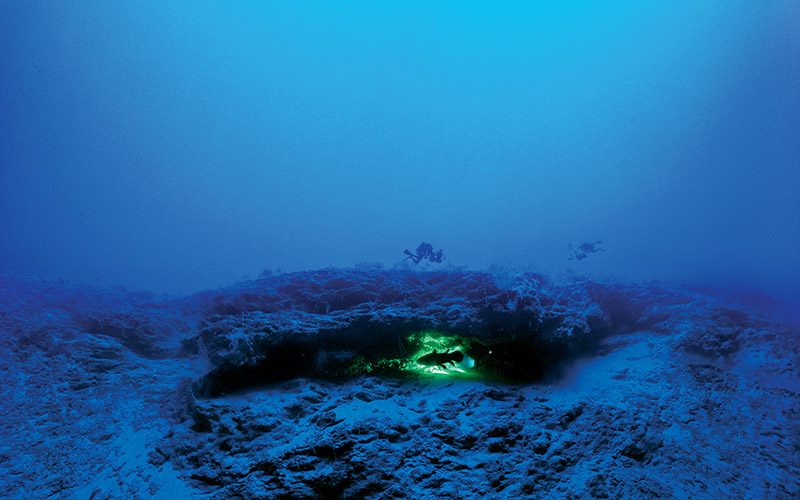
The Mediterranean Sea is known for its spectacularly clear water, particularly in the south of France. But this clarity is not found off Montpellier, where Ballesta grew up. A far cry from the French Riviera, Montpellier’s coastline is characterized by muddy green water, rough seas and poor visibility. The snorkeling and diving are arduous, and the environment does not readily reveal charismatic sea creatures. In fact, the visibility is often so poor you can see your watch or dive computer and little more. But such an environment will teach someone who cares to look for marine life how to detect it. Studying this almost imperceptible marine life was Ballesta’s childhood passion and likely the first steps along his path of an illustrious career as a marine scientist and an underwater photographer of the highest caliber.
Like many underwater photographers, Ballesta was first inspired by the exploits of Capt. Jacques Cousteau. But as a child watching the documentaries on French television, he didn’t want to be a filmmaker like Cousteau or the skipper of the Calypso. In his fantasies he was the marine biologist on board — the man who would find the rare and unusual creatures and point them out to Cousteau. Cousteau died when Ballesta was a teenager, which was a great disappointment to the young man. He would have to find another path that related to the sea.
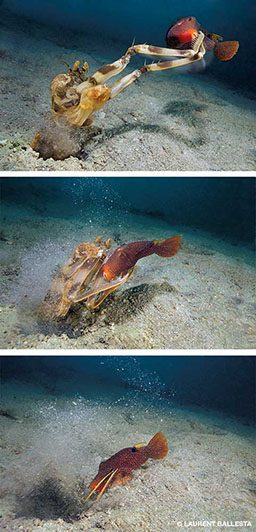
His first passion for the ocean world was to observe it; his second was talking about what he saw. He would bore friends and family with constant stories about the weird and wonderful creatures he discovered in Montpellier’s turbid waters. Eventually one of these offshore encounters drove him to try underwater photography.
While looking for a deep wreck to dive, Ballesta and his buddy saw the giant dorsal fins of a school of basking sharks swimming nearby. The water was cold, dark and dirty, but he swam with the baskers. He didn’t have words in his vocabulary to describe what he had seen when he went home to his parents, and in their eyes he could see skepticism. Right then he knew he needed an underwater camera, and his dad agreed to buy him a Formaplex Aquamatic. The camera used 126 film (28 mm square), and flashbulbs provided the only artificial light. But as crude as the system was, he could take pictures underwater.
A few years later he convinced his dad to buy him his first modern camera, a Nikonos V with an SB-105 flash. Once Ballesta finished his education and had an assignment for a science expedition in French Polynesia, he went to the bank to get a loan for a Nikonos RS. Finding the versatility of a housed single-lens reflex (SLR) camera better suited to his needs, he bought a Nikon F100 and a Seacam underwater housing, and he has stayed with those two brands ever since. Today his favorite camera is a Nikon D4S because of its ISO sensitivity and ability to perform well in low-light situations (he sometimes uses ISO settings as high as 30,000 for low ambient light). He uses a housing with a special deepwater dome port to withstand the crushing pressures of the deep depths to which he dives.
After earning his master’s degree in marine ecology at the University of Montpellier, Ballesta and three partners founded Andromede Oceanologie, a firm specializing in underwater mapping of the seafloor, studies of pollution and surveys of harbors and other coastal areas. Andromede Oceanologie also conducts pure research, particularly in deep Mediterranean ecosystems. To this end Ballesta and his partner, Pierre Decamp, have developed competency for rebreather diving in depths to 600 feet. But this is not deep diving for its own sake; it’s expedition diving for the purpose of solving scientific mysteries, producing media content such as photo galleries or books, and enhancing human knowledge about dive technology and physiology.
STEPHEN FRINK: I think I first became aware of your work through a very unusual series of images of a mantis shrimp catching a fish. This was in 1999, so it almost had to have been made with film. I thought these photos were cutting edge at the time, and they’re still quite innovative. How did you get the shots?
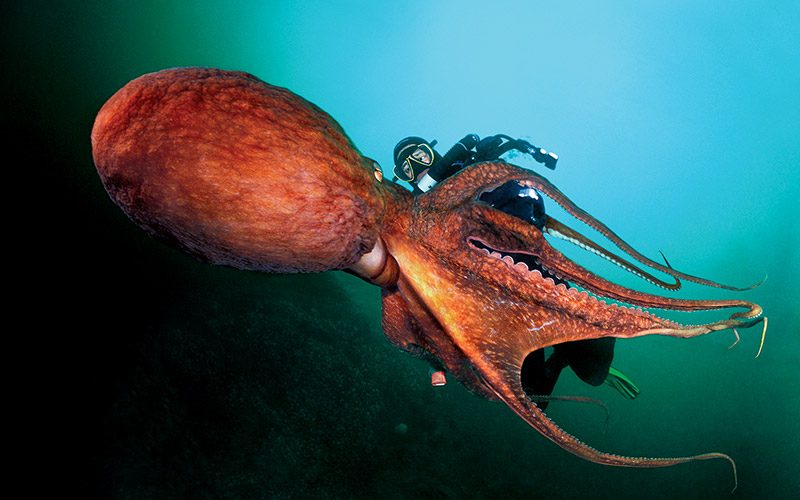
LAURENT BALLESTA: As a marine biologist I knew that the mantis shrimp has a punch of amazing speed — some say like the speed of a bullet. I understood that to capture that speed would be quite a challenge. I was at Loloata Resort near Port Moresby, Papua New Guinea, and the guides there knew of a large and relatively accessible mantis shrimp at a nearby reef. So the elements were right to try for the shot, but I still needed it to catch a fish and then capture that on film.
I spent two days hoping to get the shot by luck — well, maybe a little more than luck for I confess I tried to coax a few fish into striking range of the mantis shrimp. But I think the reef fish knew very well where this mantis shrimp lived and wouldn’t go near its tunnel on the seafloor. Finally I set up my housed Nikon F100 on a tripod with a cable release and aimed the strobes toward where the shrimp would exit its hole. I set the motor drive to the highest speed and the strobes to the lowest power so they could recycle almost immediately for a burst of 10 or 12 frames. I did a test to find the right aperture, again for the distance at which the mantis shrimp would be when attacking prey in ambush. Then I swam away and left it all in place overnight. This led the fish to accept the new object in their habitat. I also think it might have disrupted their normal patterns, because when I went down to the reef on the third day a small sharpnose puffer swam too near the mantis shrimp. When it got close I pressed the cable release in anticipation of possible predation, and I captured a burst of shots, though I didn’t see anything. I noticed the fish was gone, but neither my dive buddy nor I knew what happened to it. It wasn’t until I had the film processed that I realized I had gotten the shot.
That has been my approach to underwater photography from the very beginning. I try to imagine an impossible photo and find a way to capture it. Mostly it doesn’t work, but sometimes it does, and I will have a photo, recorded in what I hope is an artistic way, that science hasn’t seen before.
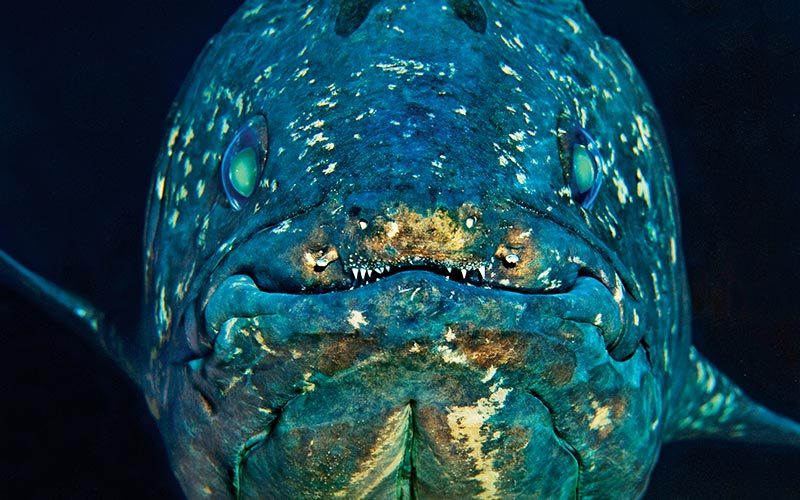
SF: Tell me more about your work with coelacanth. If the mantis was your most unusual image early on, your expedition to photograph these living fossils has excited a lot of contemporary interest in your work.
LB: As a student of marine biology it was impossible to not have heard about the coelacanth. They were known from fossil records but thought to have gone extinct 65 million years ago in the great extinction event that killed off the dinosaurs. A museum curator aboard a South African fishing trawler discovered the first living coelacanth in 1938. They are large fish, up to 6.5 feet long, and very distinctive looking with a pair of lobed fins that extend from the body. They live very deep, some as deep as 2,300 feet below the surface. By the time I was studying them in school there were specimens of them in museums, and fishermen sometimes caught them. They had been seen via remotely operated vehicles (ROVs) and submarines, but no one had ever photographed one in the wild.
In 2000 I heard that a diver named Peter Timm had actually seen a coelacanth in South Africa off Sodwana Bay on a deep dive to 400 feet. After he told what he had seen, two other divers tried the same dive with cameras, and they both died. In my experience there is a huge difference between a touch-and-go dive and a working dive at these kinds of depths. Anyone can take a mixed-gas course and learn how to reach a target depth and safely return to the surface. It is a different matter to do so in a 13-foot swell and a 2-knot current and then perform a task when you get to the bottom. This is dangerous for anyone without the necessary skills, and when I first heard there was a place where people knew there was a coelacanth, I did not have the skills to get the shot.
By 2008 I had been diving to 660 feet regularly. These were eight- or nine-hour dives, often in rough water. At that point I was working with a great team of divers; we knew each other’s abilities and trusted each other. We went to dive with Timm, and after about two weeks he gained enough confidence in us that he agreed to take us to the site. This was an exploratory expedition, but it was very successful. National Geographic ran some of those first images, and there was a lot of excitement about the fact that we had gone so deep and gotten the shots. Yet there was much more to do to really record not only the fish but also the ecosystem. We knew we could get the images of the coelacanth I had in my mind’s eye, so we got the necessary permits.
But such an expedition is expensive. We had a budget in mind of 1 million euros, and we needed a sponsor. For two years I went to meetings with corporate sponsors, armed with the photos I’d already taken and my dreams about how to do an expedition bigger and better, but I received only rejection and humiliation. Then I had an appointment with luxury watch manufacturer Blancpain. To my great delight, the president and CEO of Blancpain, Marc Hayek, joined the meeting. He is a diver and underwater photographer and immediately understood what I was trying to accomplish. Within five minutes I knew we would move forward. The Gombessa Project (gombessa is the South African name for the coelacanth) successfully documented the fish and habitat, and then we moved forward with Gombessa II.
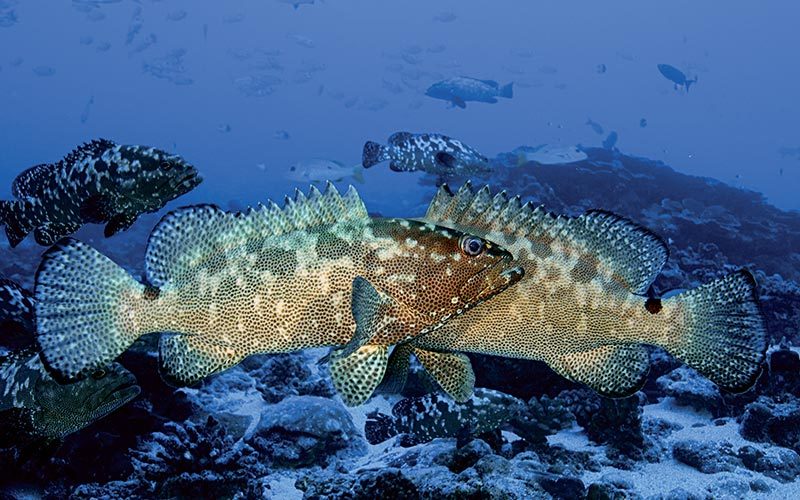
SF: I do know a little about Gombessa II, in which you and your team in 2014 went to the south pass of Fakarava atoll in French Polynesia to document the mating aggregation of the marbled or camouflage grouper,Epinephelus polyphekadion.Thousands of fish congregate during the full moon in June, and I know you were there to get stills and video of that phenomenon. But you also spent 24 hours continuously underwater on that expedition — tell me about that.
LB: I had known about the aggregation since 2000, but when we went we wanted to be able to advance the science. We wanted to count the grouper, count the sharks that come in for the spawn and record the mating of the grouper. As for the 24 hours underwater, I didn’t want to do that as a stunt. There are behaviors that happen all day and all night, so it was a valid approach for that reason, but we also wanted to do 24 hours at 66 feet or deeper to meet the associated technological and physiological challenges and thus improving our knowledge and operational capabilities.
My friend and diving supervisor, Jean-Marc Belin, and I spoke to commercial diving specialists at Comex about how to do such a dive, and they told us what we already knew: To dive to 66 feet for 24 hours would require decompressing for another 20 hours. That’s not at all what I had in mind, so I went to see other experts, this time the people responsible for the Chunnel, the tunnel beneath the English Channel that connects France and the U.K. This project had to contend with workers at depth, just as the construction of the Eads and Brooklyn bridges in the United States did in the late 1800s. As most scuba divers know, that’s when “caisson disease” (decompression sickness) was discovered, and I hoped the knowledge had advanced since then.
In consultation with this team of scientists we came up with a dive protocol that used 10 percent oxygen heliox as our basic mix for the first 18 hours and almost pure nitrogen with a small amount of oxygen after that. This allowed me to ascend in only two hours and 20 minutes. I felt remarkably fresh and happy afterward, aside from my teeth being sore from holding a mouthpiece in place for 24 hours. I know this oversimplifies what was a fairly complex and daunting element of our expedition.
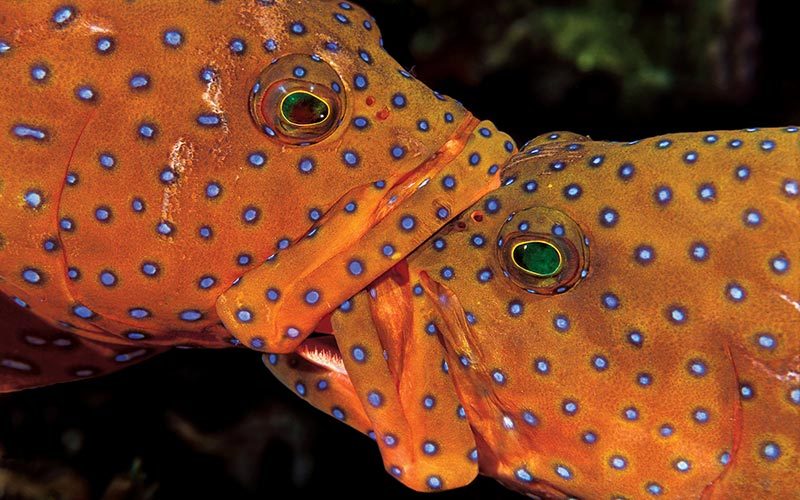
SF: I know you said you use a special dome for working so deep. Are there other special preparations you have had to make for your camera housing to work at such depths? It seems the springs for the buttons and shutter release would need to be modified as well.
LB: I would say that the critical points for dives deeper than 330 feet are the dome and, even more challenging, the flat port for the macro lens. Harald Hordosch of Seacam built and tested special ports for me that are thicker and more resistant to pressure. The other difficult aspect was the buttons. Deeper than 300 feet, normal springs won’t return to their initial position after you press them. Hordosch replaced all the springs with ones that have higher tensile strength. It hurts my finger to press the buttons, but they work. As for the housing itself, it is much more pressure resistant. It can go to at least 660 feet — I know because I’ve taken it there.
SF: What’s next for you?
LB: Stay tuned for our Antarctica Expedition. With the ongoing support of Blancpain we will collaborate with Luc Jacquet, the creative genius behind March of the Penguins, for unprecedented deep dives under the ice. Deep, dark and cold — it will certainly be a challenge for our team, and we hope to further science as a result.

Explore More
© Alert Diver — Q4 Fall 2015
